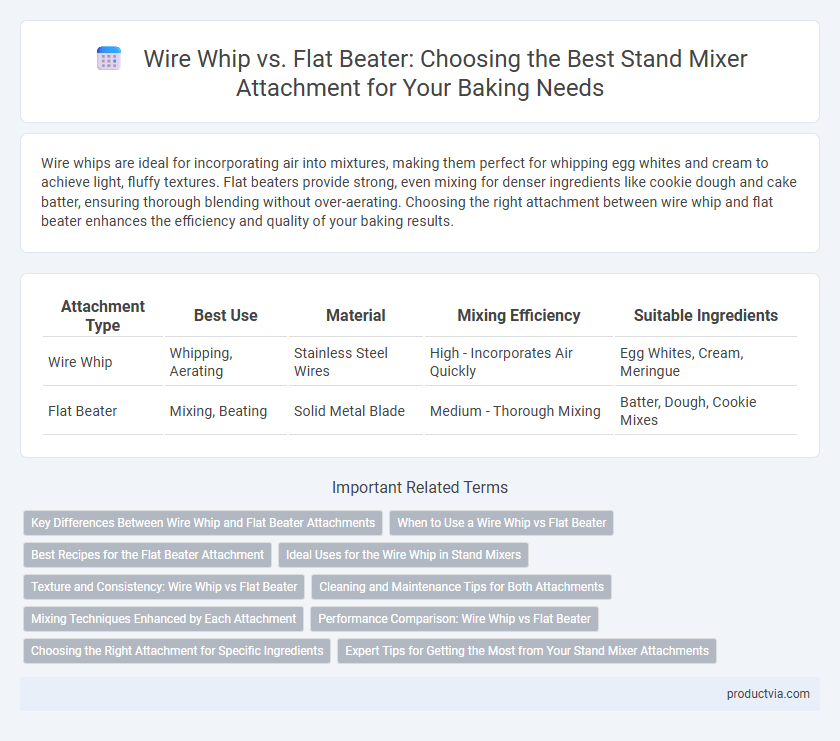Wire whips are ideal for incorporating air into mixtures, making them perfect for whipping egg whites and cream to achieve light, fluffy textures. Flat beaters provide strong, even mixing for denser ingredients like cookie dough and cake batter, ensuring thorough blending without over-aerating. Choosing the right attachment between wire whip and flat beater enhances the efficiency and quality of your baking results.
Table of Comparison
| Attachment Type | Best Use | Material | Mixing Efficiency | Suitable Ingredients |
|---|---|---|---|---|
| Wire Whip | Whipping, Aerating | Stainless Steel Wires | High - Incorporates Air Quickly | Egg Whites, Cream, Meringue |
| Flat Beater | Mixing, Beating | Solid Metal Blade | Medium - Thorough Mixing | Batter, Dough, Cookie Mixes |
Key Differences Between Wire Whip and Flat Beater Attachments
Wire whip attachments are designed to incorporate air into mixtures, making them ideal for whipping cream, egg whites, and meringues with a light and fluffy texture. Flat beaters provide thorough mixing and are best suited for heavier mixtures such as cookie dough, cake batter, and mashed potatoes, ensuring even consistency without over-aeration. The key difference lies in their function: wire whips aerate and lighten mixtures, while flat beaters blend and combine ingredients efficiently without introducing excessive air.
When to Use a Wire Whip vs Flat Beater
The wire whip is ideal for incorporating air into light mixtures like egg whites, whipped cream, and mousse, creating a fluffy, airy texture. The flat beater excels at mixing medium-thick batters, such as cookie dough, cake batter, and mashed potatoes, ensuring thorough ingredient integration without over-aeration. Choosing the appropriate attachment boosts mixing efficiency and texture quality in various baking and cooking tasks.
Best Recipes for the Flat Beater Attachment
The flat beater attachment for stand mixers excels at mixing cake batters, cookie dough, and frostings, ensuring smooth, even blends without overworking the ingredients. Ideal for medium-to-heavy mixtures, it efficiently combines fats and sugars, creating optimal texture for classic recipes like chocolate chip cookies and buttercream frosting. Unlike the wire whip that incorporates air, the flat beater maintains dense consistency essential for pie crusts and mashed potatoes.
Ideal Uses for the Wire Whip in Stand Mixers
The wire whip attachment in stand mixers is ideal for incorporating air into mixtures, making it perfect for whipping cream, egg whites, and creating meringues with light, fluffy textures. It excels at aerating batters and mixtures that require volume and smooth consistency, which the flat beater cannot achieve as it is designed for denser doughs and heavy mixtures. Choosing the wire whip ensures optimal results in recipes demanding delicate aeration and soft peaks.
Texture and Consistency: Wire Whip vs Flat Beater
The wire whip attachment aerates mixtures by incorporating air, resulting in light, fluffy textures ideal for whipped cream and meringues. The flat beater provides consistent mixing power for denser, batter-like consistencies such as cookie dough or cake batter, ensuring smooth, uniform blends. Choosing wire whip or flat beater depends on the desired texture and consistency of the recipe being prepared.
Cleaning and Maintenance Tips for Both Attachments
Wire whips require thorough cleaning to remove trapped dough or batter particles, often benefiting from a soak in warm, soapy water to loosen residue. Flat beaters, with their wider surface area and fewer crevices, typically clean more easily, allowing for quick rinsing and wiping to prevent buildup. Regular inspection and prompt washing of both attachments ensure optimal performance and prolong their lifespan in stand mixer use.
Mixing Techniques Enhanced by Each Attachment
The wire whip attachment excels at incorporating air into mixtures, making it ideal for whipping egg whites, cream, and creating light, fluffy textures. The flat beater attachment provides efficient mixing and creaming for denser batters, such as cookie dough, cake mixes, and mashed potatoes. Each attachment enhances specific mixing techniques by optimizing aeration or thorough blending based on the consistency of ingredients.
Performance Comparison: Wire Whip vs Flat Beater
The wire whip excels in incorporating air into mixtures, making it ideal for whipping cream and egg whites to achieve light, fluffy textures. The flat beater delivers robust mixing power suited for denser batters and doughs, ensuring thorough ingredient integration without over-aeration. Choosing between the wire whip and flat beater depends on the desired texture and mix consistency, with the former optimized for aeration and the latter for heavy-duty mixing.
Choosing the Right Attachment for Specific Ingredients
Wire whips are ideal for incorporating air into light mixtures like egg whites and cream, producing fluffy and voluminous results. Flat beaters excel at mixing denser ingredients such as cookie dough, cake batter, and mashed potatoes, ensuring even consistency without overworking the mixture. Selecting the appropriate attachment for specific ingredients enhances texture and efficiency in baking and cooking tasks.
Expert Tips for Getting the Most from Your Stand Mixer Attachments
Wire whip attachments excel in incorporating air into mixtures, making them ideal for whipping egg whites and cream to achieve light, fluffy textures. Flat beaters provide robust mixing power suited for denser batters and doughs, ensuring thorough blending without overworking ingredients. Expert tips emphasize selecting the correct attachment to optimize texture and consistency, such as avoiding the wire whip for heavy dough to prevent damage and choosing the flat beater for cake batters to maintain structure.
Wire whip vs Flat beater for attachment types Infographic

 productvia.com
productvia.com